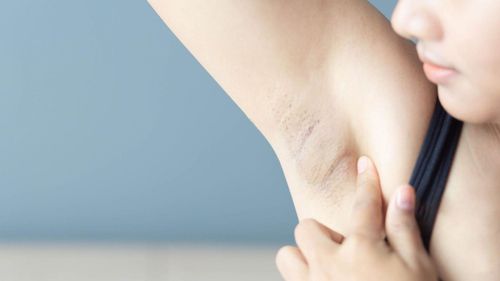This is an automatically translated article.
The article was professionally consulted by MSc Nguyen Ngoc Khanh, Head of Department of Gastroenterology - Urology - Robotic Surgery & Pediatric Surgery, Vinmec Times City International Hospital.Excessive sweating makes people feel uncomfortable, lack of confidence in communication as well as at work. So is there a way to treat this condition?
1. What is hyperhidrosis?
Hyperhidrosis is a state of excessive sweating compared to normal physiology. Sweating mechanism: Sweat is produced by glands located in the dermis layer of the skin, which helps the body regulate temperature. Sweat glands are found all over the body, but are most concentrated around the forehead, armpits, palms and soles.
Some people sweat excessively (increased sweating) even when resting or working a little, hands and feet are always wet, sometimes dripping into droplets, causing inconvenience in communication and work (wet all objects held by the patient).
2. How many types of hyperhidrosis are there?
Hyperhidrosis has 2 types: primary and secondary.
Primary hyperhidrosis : The cause of primary hyperhidrosis does not stem from any disease in the body. Often no cause can be found, especially in people with a family history of hyperhidrosis. The abnormal sweating makes the patient uncomfortable, lack of confidence in communication and work.

Secondary hyperhidrosis : Common in people with hyperthyroidism .
Hyperthyroidism is an excessive amount of thyroid hormone in the blood. They speed up the metabolism in the body, leading to a rapid heart rate and profuse sweating. Common signs of hyperthyroidism include a feeling of heat in the body, irritability, increased appetite, increased appetite, rapid weight loss, bulging eyes, fatigue, and difficulty sleeping.
3. Manifestations of hyperhidrosis
Increased facial sweating or blushing: Excessive facial sweating makes the patient uncomfortable. Patients also often have episodes of blushing, especially when someone teases or affects communication. Increased hand sweating: When the patient shows signs of anxiety, the hands sweat a lot. Because the hands are an important part of social or occupational contact, many patients have autism and avoid contact, are reluctant to shake hands, limit working with documents, cannot write or smudge ink. , ... or may be confused when holding hands, shaking hands of others. Increased sweating under the armpits, feet and other places that cause unpleasant odors.
4. Treatment of hyperhidrosis
Antiperspirants: These are simple and recommended first-line medications, used in patients with mild or moderate hyperhidrosis. Types that may be on the market: Drysol, ArmsUp, Odaban, Mitchum Clear Gel Sport Drugs: The drugs used are mainly anticholinergics, with or without sedatives. They are often used in general hyperhidrosis (body, groin, thighs, head,...). Commonly used drugs are Propantheline bromide, Propranolol SR,... Ion transfer (Drionics machine): This method is applied when the use of drugs is not effective. Treatment involves applying a low-intensity electrical current to the patient's arm or leg in an electrolyte solution, several times a week. Results are unusual and many patients consider time-consuming and expensive. Difficult to perform in patients with axillary and facial hyperhidrosis. Currently, this method has not been implemented in Vietnam. Botulinum Injection: Botulinum is a substance produced by the bacterium Clostridium Botulinum, which acts on the neurotransmitter (acetylcholine) at the junction. It is used to treat hyperhidrosis due to its paralyzing effect of the sympathetic nervous system, by injection into the armpit or hand. The effects are temporary and require injections more than twice a year, so the cost of treatment is often high.5. Treatment of hyperhidrosis with endoscopic surgery
Vinmec Times City International General Hospital is applying the technique "Throat endoscopic sympathectomy" in the treatment of hyperhidrosis: This is a new technique that has been applied in the past few years and has been bring many positive signals to patients. Surgery is only applicable to people over 18 years old.
Endoscopic thoracic sympathectomy, also known as sympathectomy, is surgery to destroy the sympathetic ganglia or the chain of ganglia that governs sweating. Surgery is performed routinely under general anesthesia. Specifically, the surgery is performed with 2-3 small 0.5 cm skin incisions on both sides of the chest wall under the armpits so that no scars are visible, ensuring the best aesthetics. The thoracic sympathetic ganglia is covered by a thin layer of transparent pleura, so it can be easily seen under the endoscopic camera. Then the surgeon uses an electrocautery hook and cuts the sympathetic ganglia from the 2nd thoracic vertebra to the 3rd thoracic vertebrae (the technical term is T2–>T3) for the patients with increased sweating in the hands. ; T2 - T4 for patients with axillary hyperhidrosis.
In addition, at Vinmec, we also treat hyperhidrosis with electrostatic ions with outstanding advantages such as:
Safe and effective treatment methods. Creates a negative ion environment to help eliminate free radicals in the body. The ion flow affects the sympathetic nervous system in the area of hypersecretion, helping to balance ions and prevent unexplained sweating.
Please dial HOTLINE for more information or register for an appointment HERE. Download MyVinmec app to make appointments faster and to manage your bookings easily.














